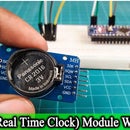Introduction: How to Blink an LED (Tinkercad)
Introduction to Basic Arduino LED Circuit
#### **Project Overview:**
In this basic project, an LED is connected to the Arduino, and it is programmed to turn on and off at regular intervals. This serves as a hands-on introduction to the core concepts of digital outputs, circuit design, and programming logic.
#### **Key Learning Objectives:**
1. **Understanding the Arduino UNO:** Learn about the main features and functions of the Arduino UNO board, including digital and analog pins, power supply, and USB connection.
2. **Circuit Building:** Get hands-on experience in assembling a simple circuit using a breadboard, LED, and jumper wires.
3. **Basic Programming:** Write and upload a simple program to the Arduino to control the LED, introducing the fundamentals of coding and logic in the Arduino IDE.
4. **Debugging and Testing:** Learn to troubleshoot basic circuit connections and code issues to ensure proper functionality of the setup.
#### **Applications:**
- **Educational Tool:** Perfect for students and hobbyists to understand the basics of electronics and programming.
- **Prototyping:** Provides a foundation for building more complex projects like automation, robotics, and IoT applications.
Supplies
In the provided image, there are 4 main hardware components being used:
- Arduino UNO Board - The microcontroller board that controls the circuit and executes the code.
- Breadboard - A platform for building and testing circuits without soldering.
- LED - A light-emitting diode used as an output to indicate the circuit’s functionality.
- Jumper Wires - Used to connect the components on the breadboard to the Arduino board.
Step 1: Complete Arduino LED Blinking Project: Step-by-Step Guide
To recreate the project shown in the image, you will need the following hardware components visible in the image:
### Hardware Required:
1. **Arduino Uno Board**
2. **USB Cable for Arduino (to connect to the computer)**
3. **Breadboard**
4. **1 x LED**
5. **2 x Jumper Wires**
### Steps to Create the Project:
1. **Connect the LED to the Breadboard:**
- Place the LED on the breadboard such that the longer leg (anode) is in one row and the shorter leg (cathode) is in another row.
2. **Connect Jumper Wires:**
- **Anode Connection:**
- Use a jumper wire to connect the longer leg (anode) of the LED to Digital Pin 13 on the Arduino board.
- **Cathode Connection:**
- Use a jumper wire to connect the shorter leg (cathode) of the LED to the GND (ground) pin on the Arduino board.
3. **Connect the USB Cable:**
- Connect the USB cable to the Arduino board and plug it into your computer.
4. **Upload the Code:**
- Open the Arduino IDE on your computer.
- Use the following code to make the LED blink:
```cpp
// Pin number where the LED is connected
int ledPin = 13;
void setup() {
// Initialize digital pin 13 as an output.
pinMode(ledPin, OUTPUT);
}
void loop() {
// Turn the LED on (HIGH is the voltage level)
digitalWrite(ledPin, HIGH);
// Wait for a second
delay(1000); // Turn the LED off by making the voltage LOW
digitalWrite(ledPin, LOW); // Wait for a second
delay(1000);
}
```
5. **Start simulation or Upload and Run **
- Click on the upload button in the Arduino IDE to upload the code to the Arduino board.
- The LED should now start blinking on and off every second.
This setup uses only the components visible in the image. If you have any further questions or need assistance, feel free to ask!
https://youtube.com/@steam-diy?si=E89-qslXLpB8WD3_
Subscribe STEAM DIY for more projects
Thanks
Step 2: Video Tutorial
video tutorial



![Tilt Sensor With Arduino Nano [Code and Circuit Diagram]](https://content.instructables.com/F02/YOT1/M31LRV3L/F02YOT1M31LRV3L.png?auto=webp&crop=1%3A1&frame=1&width=130)
